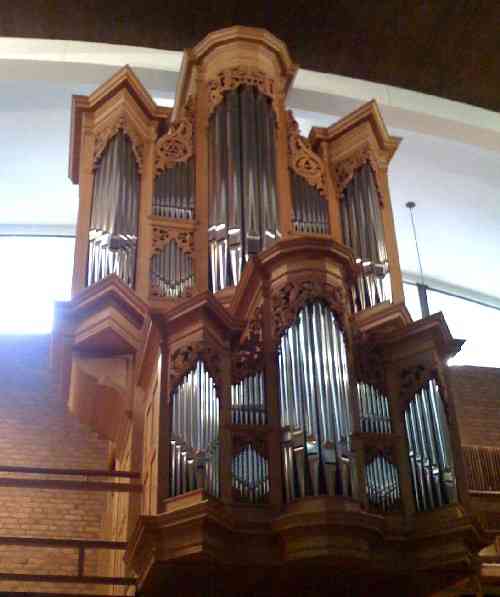
B egin with simple ingredients, such as a melody limited only to three notes, then four, then five, etc. Exploit a certain interval—for example, the major second or the tritone. Improvise a short motive—for example, B-A-C-H (B-flat, A, C, B-natural)—and transpose it, invert it, augment it, condense it, expand it. Improvise melodies within the compass of the octave. Imitate various instruments or voices and styles. Use all keys, modes, and meters. You can do this!”T he BEMF organ mini-festival included segments yesterday offered by Joan Lippincott on Bach’s ‘Art of the Fugue’, by Bálint Karosi and Chris Brown on ‘Rhetorical Forms in Lutheran Worship’ illustrated by works of Böhm, Buxtehude, and Bach, and by William Porter on comparing the fantasias, fugues, and sonatas of J.S. Bach and C.P.E. Bach.
— Jan Overduin, Improvisation for Organists, p. 7.

J oan Lippincott is Professor Emerita of Organ at Westminster Choir College of Rider University, Princeton. She trained with Alexander McCurdy at Curtis Institute and for some years was principal organist at Princeton University. Her activities concertizing and recording currently occupy her full-time.

B álint Karosi is presently Minister of Music and principal organist at First Lutheran in Boston. He was born 1979 in Budapest, Hungary, and began playing piano and clarinet at age 6 and at 16 he began to study the pipe organ. In the 1990s, he studied at the Ferenc Liszt Academy of Music with Gábor Lehotka. Subsequently, he was at the Conservatoire Superieure de Musique de Geneva with Lionel Rogg from 1999-2001, where he was awarded the ‘Prix de virtousité avec distinction’ in both organ and clarinet. He has two Masters degrees from Oberlin, studying with James David Christie. He was the winner of the 2008 J. S. Bach international organ competition in Leipzig, Germany. His honors also include an award for best modern improvisation at the organ competition in Brno, second prize at Prague’s Spring International Clarinet Competition, first prize and the audience prize at the Dublin International Organ Competition, first prize at the Arthur Positer Organ Competition in Syracuse and second prize at the St. Maurice International Organ Competition in Switzerland.
T he beautiful Kellner-tempered Richards, Fowkes ‘Opus 10’ (delivered to FLC in December 2000) is a joy to hear. The 70 mmH2O (0.1 psia) wind-pressure has plenty of power and CFM flow-capacity to fill the tall, austere, brick-and-oak, barrel-ceilinged Lutheran sanctuary. The Posaune 16' and Sub-bass 16' ranks give impressive sounds that can be put to a variety of innovative, coloristic religious and secular purposes. The low end is also aided by Bourdon 16', Dulcian 16' and Krummhorn 8' on this instrument.
T he First Lutheran congregation in Boston was founded in 1839 as the German Lutheran Society and is the oldest Lutheran congregation in New England. The church, at Marlborough and Berkeley streets in historic Back Bay, was designed in 1957 by MIT Dean of Architecture, Pietro Belluschi. In 1995, Professor William Porter and church organist, Mark Meyer, initiated the process commissioning this new Kellner-tempered Richards, Fowkes instrument.
T he BEMF organ mini-festival afforded an excellent chance to consider Brad Lehman’s ideas about Bach’s temperament—especially in the Bach Contrapuncti in D minor and other works in flat keys.
A ll those major and minor keys sound objectively different from one another, having slightly different semitone and tone arrangements in their scales, and different harmonic balances of the triads and more complex chords. These differences render all the keys recognizably distinct, as to the tensions and resolutions in the way tonal music behaves. The triads and diatonic scales of F and C majors are the closest to regular 1/6-comma temperament. D major and E-flat major each have an average quality resembling equal temperament. The scale of E major is the closest to Pythagorean tuning. We have the complete flexibility of modulation as if it were equal temperament, but also a third dimension of depth: natural motion forward through the music, in a well-organized and dramatic manner. … Short of hearing this directly for oneself at a keyboard instrument, how may we describe the most noticeable musical effects of the temperament? Sharps are high and bright, with a strong and rather ‘hard’ (dur-) tone that creates ‘forward motion’ when they are used in dominant triads. Flats seem warm and vibrant, ‘soft’ (moll-) and gentle, with a shimmer to their chords and scales. The naturals, with the exception of B, have the same neutral and resonant character that they do in a complete 1/6 comma layout. The biggest difference here, as compared with other familiar ‘well-temperaments’ like Kellner’s, is the treatment of the flats. With the sharps placed so uncommonly high, the major and minor 3rds are especially euphonious when those same levers are played on the keyboard as flats. They serve very well as the tonic under natural notes, making major 3rds (for example, D-flat under F, or A-flat under C).”T he performances also afforded a special opportunity to hear the rhythmic control and clarity that are possible with the excellent tracker mechanism design by Richards, Fowkes Organ Company. A tracker organ is one where the key action physically connects the keys and the windchests through a series of rods called ‘trackers’. When the organist presses a key, the corresponding tracker moves, and wind enters the pipe corresponding to the key pressed. (This is contrasted with a ‘mechanical stop’ action, where each stop control is physically connected to a rank of pipes. When the organist activates the stop control, the action allows wind to flow into the selected rank of pipes. This control is usually a stop-knob, which the organist activates by pulling towards himself/herself.) The tracker mechanism usually entails somewhat greater finger effort in playing but achieves a more direct keyboard ‘feel’ and a more responsive control of the pipes’ valves, a big plus for fast, virtuosic passages.
— Brad Lehman, Univ Michigan.
C P. E. labeled the final page of Bach’s manuscript with the message that Bach died while introducing B-A-C-H as a countersubject in the third part of the fugue. Ignoring for the moment that B-A-C-H is here a subject, not a countersubject, the whole story [that this Contrapunctus was composed by Bach on his deathbed, pen falling from his hand in the midst of measure 239] is apocryphal [false]. The piece was further labeled ‘Fuga a 3 Soggetti’ (Fugue with 3 Subjects) in the 1751 published edition, despite that fact that it was patently Bach’s intention that it be a quadruple (four-subject) fugue. But how can we be sure of that?”T he incompleteness of ‘Die Kunst der Fuge’, BWV 1080, will probably always remain controversial. Bach probably started writing it sometime in the 1740s or maybe earlier. The first known surviving version, which contained 12 fugues and 2 canons, bears Bach’s copy date of 1745. Bach’s second version was published in 1751 after his death. That one contains 14 fugues and 4 canons. Göncz about 12 years ago investigated the combinatorics of the construction of Contrapunctus XIV (see link below), coming up with new ideas that, to me, are really persuasive.
— Jeffrey Hall, FlagMusic.com.

T he sudden ending of Contrapunctus XIV in mid-sentence, in bar 239, was beautifully and dramatically rendered by Joan Lippincott, to the delight of the festival attendees. In summary, yesterday provided an emotionally moving and very illuminating session—one that I hope leads to follow-on organ mini-festival offerings in future years’ BEMF programs.

Denn gleich wei di Rosen stehen As fair roses are bounded unter spitzen Dornen gar, By sharp thorns on every side, also auch die Christen gehen So with perils sore surrounded in viel Angsten und Gefahr... Christians in this world abide... Ob mire schon die Augen brechen, Though my eyes should dim, and hearing das Gehor auch gar verschwind't; Fail in silence quite away; meine Zung nicht mehr kan sprechen, Though my tongue should cease from speaking, bist du doch mein Licht, mein Wort. You are still my Light and Word.
— Old-School Lutheran rhetoric (‘Freu dich sehr, O meine Seele’)
- Boston Early Music Festival website
- Joan Lippincott page at ConcertOrganists.com
- Joan Lippincott at McFarlane Artists Inc.
- Lippincott J. The Fenner Douglass Organ. (Gothic, 2007.)
- Balint Karosi page at Wikipedia
- Bálint Karosi at First Lutheran Church, Boston
- Richards, Fowkes & Co. pipe organs
- Chris Dylan Bailey’s counterpoint page at Columbia Univ
- Counterpointer tutorial software at Ars-Nova.com
- Alan Belkin counterpoint page at Univ Montreal
- Counterpoint page at Wikipedia
- American Guild of Organists website
- Audsley G. Art of Organ Building. Dover, 1988.
- Dickson W. Practical Organ-Building. BiblioBazaar, 2009.
- Göncz Z. Reconstruction of the final contrapunctus of The Art of Fugue. International Journal of Musicology 1997; 5:25–93.
- Hughes I. Accident or Design? New Theories on the Unfinished Contrapunctus 14 in J.S. Bach’s The Art of Fugue BWV 1080. PhD dissertation, University of Auckland, 2007.
- Lehman B. Mathematical analysis of Bach’s extraordinary temperament. Early Music 2005; 33:3-24.
- Overduin J. Making Music: Improvisation for Organists. Oxford Univ, 1998.
- Ritchie G, Stauffer G. Organ Technique: Modern and Early. Oxford Univ, 2000.
- Shannon J. Understanding The Pipe Organ: A Guide for Students, Teachers and Lovers of the Instrument. McFarland, 2009.
- Thistlethwaite N, Webber G, eds. The Cambridge Companion to the Organ. Cambridge Univ, 1999.
- Whitney C. All The Stops: The Glorious Pipe Organ And Its American Masters. PublicAffairs, 2004.
- Wolff C. Johann Sebastian Bach: The Learned Musician. Norton, 2001.
J osephus – I come to you, venerable master, in order to be introduced to the rules and principles of music.
Aloysius – You want, then, to learn the art of composition?
Josephus – Yes.
Aloysius – But are you not aware that this study is like an immense ocean, not to be exhausted even in the lifetime of a Nestor?”
— Johann Joseph Fux, Gradus ad Parnassum, 1725.
No comments:
Post a Comment